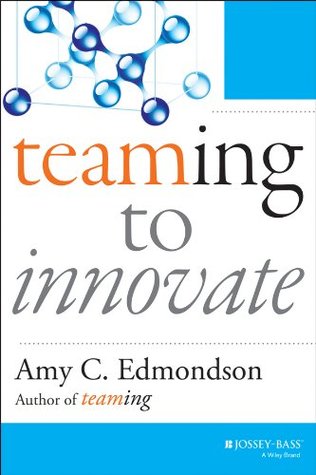More on this book
Community
Kindle Notes & Highlights
Teaming is a process of bringing together skills and ideas from disparate areas to produce something new—something that no one individual, or even a group in one area of expertise, could do alone.
This is why teaming is so crucial to innovation.
Rather than just bringing their expertise, ideas, and biases to a project and tossing them into the mix, groups that end up innovating effectively find ways to roll up their sleeves and work together. They find ways to genuinely integrate their different perspectives so as to create brand-new possibilities. This is teaming.
Innovative organizations tend to have cultures that embrace paradox. This is because innovation depends upon the coexistence of pairs of seeming opposites: play and discipline; high standards and a tolerance for failure; the use of deep experts and boundary-spanning generalists who deeply empathize with customers.
To Riboud, strategy happens when employees come up with something new, not when they follow the instruction manual.
And spreading successful innovation in a large organization requires finding ways to shine a quiet spotlight on innovators so that others are drawn to try it, too.
Setting goals, such as that of having 25 percent of a division’s revenues come from products introduced within the last five years, means that divisions must be actively experimenting to develop new products.6
In any successful organization, leadership exercises three basic levers that influence the actions of others. The first is communicating an inspiring picture of a desirable future.
The second lever is modeling desired behaviors.
The third is direct coaching and feedback,
a leader’s role in fostering innovation is to build a culture that is playful and disciplined; chaotic and focused; full of experts and broad-thinking boundary-spanners; a culture that promotes high standards and tolerates failure. A culture of possibility.
The Process Knowledge Spectrum, elaborated in Table 1 for different kinds of organizations, characterizes work according to how much knowledge we have about translating goals into results, and how well we understand the relationships between cause and effect.8
A Recipe for Innovation
In fact, without an unusual mix of openness, humility, talent, drive, and creativity, innovation may not occur.
Teaming for innovation is dynamic. It involves identifying (often temporary) collaborators and getting up to speed quickly on what needs to be done and what role each collaborator can play.
But no matter how flexible and willing one’s colleagues may be, effective teaming rarely happens spontaneously. It takes effort.
and to be stewards of the contradictory and paradoxical culture of innovation.
1. Aim High 2. Team Up 3. Fail Well 4. Learn Fast That’s basically it. It’s simple.
5. Repeat
Aim High explains that innovation is best fueled by a compelling purpose that answers the questions,
Innovation is a team sport.
Innovation comes to those who fail often and fail early (because they are finding out what doesn’t work).
The purpose—where the team is headed—usually remains firm; the process—how we do things—can usually be improved.
rescue required innovation is self-evident—there simply was no existing solution, either inside or outside the mining industry, at the outset. It took the collaborative efforts of over one hundred experts in diverse fields innovating to develop and execute a novel solution on the fly.
No one person, or even one leadership team, could have figured out how to solve this problem.
Let’s look at two core leadership principles that help drive innovation in any organization.
First, the most senior leadership in the mining disaster committed publicly to a successful outcome, risking both resources and reputation on an unlikely outcome.
Second, leaders must demand rapid cycle learning.
The hard intellectual and emotional work of innovation is fueled by a compelling purpose that addresses questions like, Why care? Why bother?
Her vision? A hospital with 100 percent patient safety. Her solution? She didn’t have one.
taking interpersonal risks, such as admitting mistakes and pointing out flawed systems to bosses and others, seems worth it. Innovating to improve patient safety gives people an opportunity to make an important positive difference.
Worthy Aspirations That Motivate Innovation
The opportunity to make a difference turns out to be a key driver of innovation. When people share an ambitious goal—together with a vision of a better future—it gives them a shared identity. It builds camaraderie.
Three types of boundaries are particularly important in the context of teaming to innovate: physical distance (location, time zone, and so on), status (perceived social value, hierarchical level, profession, and so on), and knowledge (experience, education, and so on).25
Nowadays, it’s just not possible for individuals, no matter how expert, to develop important innovations all by themselves. The chances of individual parts, developed separately, coming together into meaningful, functional wholes—a new product, feature film, or rescue operation—without intense communication across boundaries are exceedingly low.
Genuine curiosity about what others think, worry about, and aspire to achieve is invaluable for crossing boundaries.
In any complex teaming effort it is important to establish process guidelines that everyone agrees to follow.
conflict is desirable. Without conflict—the competing ideas from which new possibilities sometimes spring—innovation is less likely.
But however appealing the idea of creative conflict is in theory, in practice managing conflict effectively is hard to do.
How can people effectively use different perspectives to produce innovation rather than unproductive conflict?
To cool conflict down and find effective ways to build on others’ ideas and perspectives, my colleague Diana Smith and I recommend three practices.31 We refer to them as managing self, managing conversations, and managing relationships.
building strong relationships that can withstand the temporary assault of disagreement.


